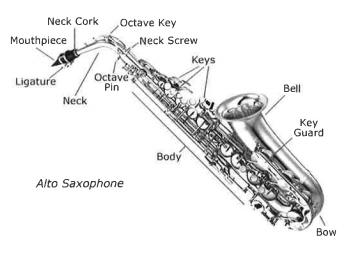Saxophone
Saxophone
What to look for when purchasing a saxophone:
- Specify the type of saxophone you want. Most students use the alto saxophone, some choose a tenor or baritone saxophone.
- A student model saxophone has all the necessary features for a beginning student. Professional models have extra features such as double-articulated pinky keys and an ‘f sharp’ key. Your child’s teacher can advise which is most suitable.
- A mouthpiece made of good quality ebonite will produce a better sound.
- Let your child feel if the key layout is comfortable.
- A neck strap is essential to carry the weight and may be purchased separately. A wide strap made of neoprene is the most comfortable.
If you purchase a second-hand instrument it will need to be serviced, consider this in the price. Your child should use their own mouthpiece and reed to test the instrument. Choose only reputable makes and models.

Diagram which shows the parts of an alto saxophone: neck cork, octave key, neck screws, keys, bell, key guard, bow, body, octave pin, neck, ligature, mouthpiece.
Equipment and expenses
Equipment and expenses
Once your child has committed to the music program, you need to make sure your child has all the necessary equipment they need.
Your child will be provided with a student music journal and you need to provide:
- a tutor book for school
- a music stand for home
- a suitable case
- accessories such as reeds, strings, rosin, cleaning products
- repairs and maintenance on owned instruments.
Some schools may also charge a small fee to cover costs associated with the program.